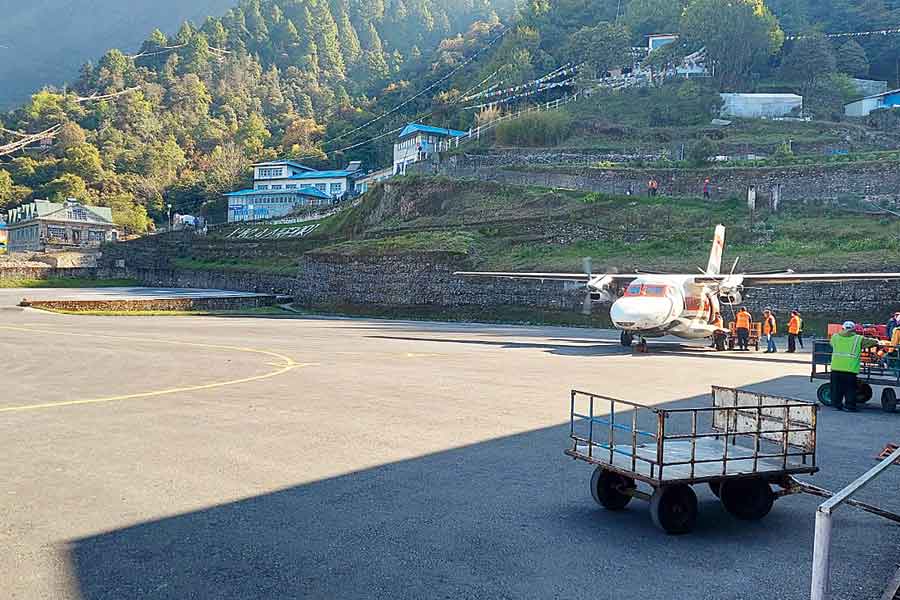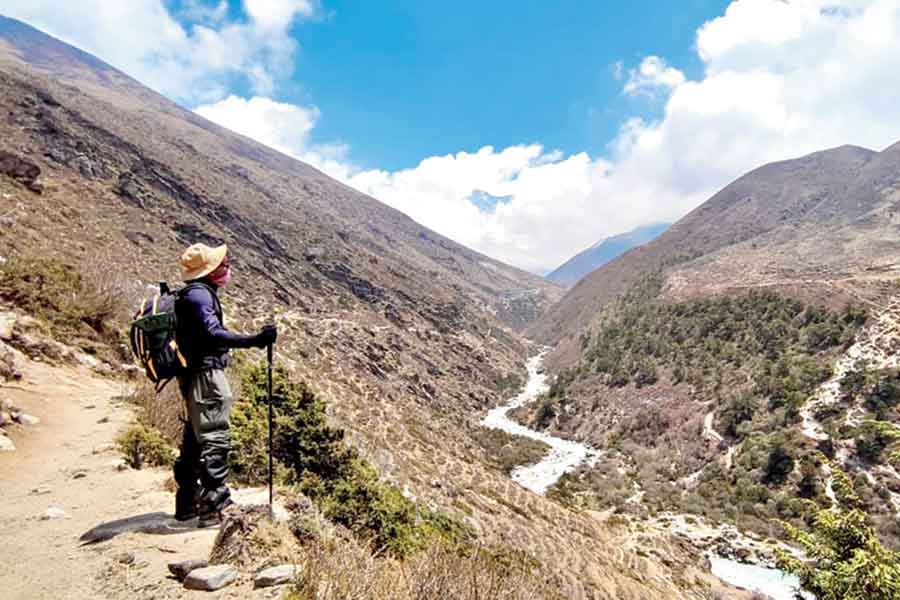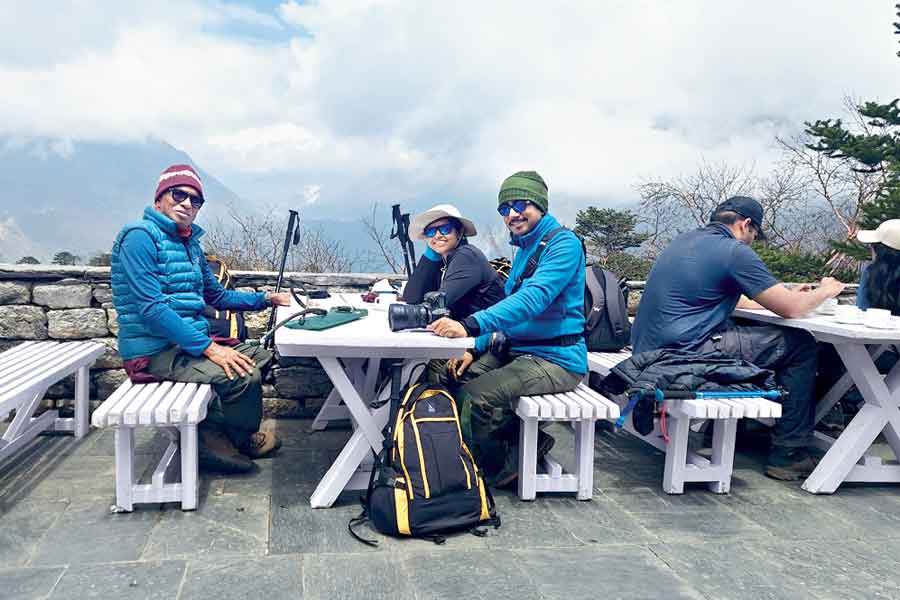It is never too late to chase a dream. Not even if one has entered the seventh decade of one’s life. Naba Kumar Mondal, all of 72 years old, has just returned to his New Town housing complex after realising a dream, the seeds of which were planted when he was a research student — watching Mt Everest from the base camp.
He speaks in a hoarse voice — the price of landing from -15C in the cauldron that is Calcutta currently — but the first thing he tells The Telegraph Salt Lake seated in his 29th floor New Town Heights apartment in Action Area III reveals his conviction: “Age is just a number”.
The retired particle physicist has trekked to the Everest Base Camp, clocking 130km over 10 days, in the company of his neighbours — Srikumar, 41, and Sudeshna Ghosh, 39.
Reel to real
What acted as a catalyst to arouse his dormant dream was an Amitabh Bachchan-starrer called Oonchai that shows three elderly friends making it to the Everest Base Camp. “When we walked out of the hall, my wife Swapna got an inkling of what I was thinking and reminded me that it was fiction,” smiled Mondal.
In his student life, at the Tata Institute of Fundamental Research (TIFR), Mondal used to go trekking with a Parsi friend around Bombay but had to discontinue due to work pressure.
Mondal retired from TIFR in 2016 and returned to Calcutta, settling down in New Town. In 2019, during a trip to McLeodGanj, he went on two day-long treks. “A batchmate casually commented that we should target the Everest Base Camp,” he recalled.
But it wasn’t till he saw the film and met his neighbours over dinner on January 28 that the ball started rolling. “’Kaku tumi jabe?’ Srikumar asked me excitedly when I shared my ambition with them. Husband and wife too had seen the film and were harbouring the same dream,” laughed Mondal. Opposition at home from wife was overruled by the “third umpire”, his son, who agreed to let him go with doctor’s clearance.
Fitness regime
So single-minded was he in his preparation that the very next morning he started training. “I would walk, gym, swim and do pranayam and yoga.” And on weekends, he would walk to Eco Park, 10km away, and back with Srikumar. And once he passed his medical tests, his doctor gave him the green light. “We never had any doubts about Kaku going along. He is the fittest among us. Never for a day did he skip his exercises,” Srikumar smiles.
Srikumar, who works in a mobile company, booked with a tour operator who would take care of their guide, permits and accommodation. Mondal’s insurance proved a problem as no firm seemed to offer the special insurance required for treks up to 6,000m to those aged above 69 years. “Going without insurance is not allowed as a rescue might require a helicopter pick-up. Finally Srikumar found one. But I had to pay Rs 28,300 as premium while they paid Rs 8,500 each,” laughs Mondal.

Lukla airport

A glimpse of Mt. Everest (centre) while trekking towards EBC from Gorakshep.
Picture by Srikumar Ghosh
Rhododendrons along the way

Memorials to climbers who died while climbing Mt Everest near Thukla Pass. (Right) The trio, Naba Kumar Mondal, Srikumar and Sudeshna Ghosh, at the observation deck restaurant of Hotel Everest View near Namche Bazar
On May 12, the three set off for Kathmandu, carrying, among other things, medicines worth Rs 3,000. “Porters would carry 10kg while each of us would carry 4-5kg plus a two-litre water bottle. Add to that the down jacket which has to be taken off when one starts walking. Two other must-haves are sunscreen, to avoid the skin peeling off in the cold, and quality sunglass, to protect against UV radiation.
On landing in Nepal, they were taken to Ramechhep by bus. From there, they boarded a 15-seater Dornier flight to Lukla, the airport closest to Mt Everest.

A pause for a photograph on the way from Tengboche to Dingboche along the Dudhkoshi river

The trek begins
The three from New Town became a part of a group of 12 to be shepherded by their guide. The walk started on a downward slope, losing altitude as hamlets pretty as pictures nestled amid greenery came within sight. “It is here that we crossed the first of the seven suspension bridges on our way,” he says.
“We were to trek 65 km, covering about 10km a day. Twice we were to go up — at Namche Bazar and Dingboche — and come back on the same day for acclimatisation.” After the first night at Phakding, they crossed a river in course of a 11km trek, entering Sagarmatha National Park, Sagarmatha being the name people of Nepal refer to Everest as. “The last three kilometers after crossing the Hillary suspension bridge and before reaching Namche Bazaar are the toughest as you are down on energy at the day’s end,” Mondal recalled.
Around 7pm, they reached Namche Bazaar, a busy market area with pubs and cafes for a two-night halt. The verandah of their hotel, Everest View, was supposed to yield the first glimpse but clouds ensured their wait would be longer.
The next day’s trek involved a descent, in course of which Sudeshna hurt her knee. “The way it got swollen, it caused us great concern but she gamely carried on,” Srikumar said. There was a river (Imjikhola) to be crossed but ahead of monsoon it was a bed of boulders. After crossing a suspension bridge, a steep climb started. But the sight of rhododendrons revived them. “We had seen rhododendron bushes at lower altitudes too. But here it was colder and hence they were still in bloom. The company of those flowers reduced our fatigue,” he smiled.
It was only after reaching Tengboche on the fourth night that they started seeing snow-capped peaks. All this while, the sky was cloudy and sighting was not possible.
More varieties of rhododendron were seen along the way to Dingboche, where two nights of stay were scheduled. But it was still cloudy. “Srikumar was upset as we still had not got a glimpse of Mt Ama Dablam which is supposed to escort us all along because of the cloud cover.” Ama Dablam is so majestic that it is called ‘Matterhorn of the East’ and overlooks the entire valley.
But they got lucky the next day. Mondal opened the window at the break of dawn and the sight of snow-peaked mountains greeted him.
“Around 5am, I got a call: ‘Srikumar, niche ay.’ I panicked thinking Uncle might be sick but when he asked me to bring the camera, I understood what to expect and rushed out,” he smiled. “There it was — Ama Dablam in its majesty among other peaks!”
The day was meant for an acclimatisation hike to Chukhung village. “Since we had not had time to explore Namche Bazar, Sudeshna and I decided to cut short the hike and come back to spend time in Dingboche. But Uncle would not waver from the plan.”
So that day despite coming back, they kept the third of their three daily mandatory phone calls to Calcutta on hold. “How could we tell auntie that we were back but uncle wasn’t?” laughs Srikumar.
They gorged on pizza at a cafe. “We needed the break as we were surviving on spinach, papad fry, daal and rice for lunch and Sherpa stew for dinner. The stew is a flat noodle soup with a lot of vegetables,” said Srikumar.
Dingboche onwards, even the bushes vanished as they were above the treeline. “There were just shrubs and boulders. After Lobuche, even the shrubs were not to be seen.”
The air was getting thinner and breathing was getting difficult. “Sudeshna, who had the least time among us to exercise and get fit, was visibly struggling but she bravely soldiered on,” Mondal recalled.
They had to cross a torrential river balancing steps on the boulders on the bed. As they started climbing, they crossed Thukla Pass, passing by the graves of those who have died at the Everest.”
Once the weather improved, they had a gorgeous sighting of a range of peaks — Nuptse, Pumori, Thamserku, Kangtega...
The trek on the eighth day to Gorakhshep had no defined route, being full of boulders strewn over Khumbu glacier, the world’s highest. “It was our best day,” said Mondal. After crossing Lobuche Pass, the 8,000m peaks come in view on all sides. It is from Gorakhshep that the Everest Base Camp has to be approached.
Mission successful
The group reached the base camp around 4.30pm on May 20. “So ecstatic was Uncle that he insisted on climbing a rock which had EBC and the height (5364m) written on it though we warned him that it was slippery. He stood on it swaying the Tricolour.”
The group asked him to deliver a speech on the spot and gave him a grand salute. “What I felt then is what I want to tell everyone reading this article. Why must we age? Elderly people too should exercise, of course with medical clearance. What is the use of living long if one becomes dormant?” argues the physicist who has climbed his way up in life from a farmer’s hut in a Burdwan village to a premier scientific research facility.
What is your message for Naba Kumar Mondal? Write to saltlake@abp.in






